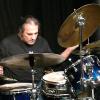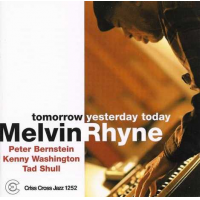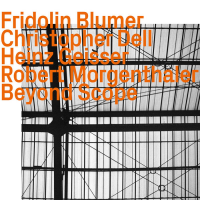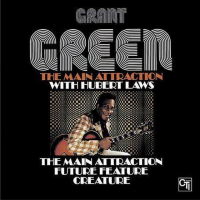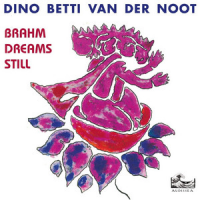Home » Jazz Articles » Liner Notes » Machine Mass: Inti
Machine Mass: Inti
"My wife Mary was very ill at that time, in October 2010 [subsequently passing away two months later]," Bianco recounts. "Michel said I should get away from it all for a bit; I was watching Mary 24/7. Being a good friend, he said, 'Come to Liege and let's record.' So I brought some music, with piano and bass loops. Michel knew of [saxophonist] Jordi Grognard, and got him to play on the recording. That week, upon waking up from sleep, the words Machine Mass were in my mind; I told Michel about it, and he thought it would be a good name for the project."
Delville adds: "The original idea was to create a duet, but we felt that an extra musician would be a plus. Tony and I have a telepathic relationship, as evidenced not only on MMT's 2011 debut, As Real as Thinking, but also in the two douBt releases we recorded with [keyboardist] Alex Maguire [2010's Never Pet a Burning Dog and 2012's Mercy, Pity, Peace & Love, all three on Moonjune]. Whenever we meet or discuss anything related to life or music there is an immediate understanding and we start to work towards the same goal."
Recruiting saxophonist Dave Liebman for Inti, MMT's sophomore outing, pushed Delville and Bianco's simpatico to an even deeper level. At 65, the youngest individual recipient of the NEA Jazz Master Fellowship—a well-deserved accolade for one of the hardest-working saxophonists in jazz, with nearly 100 albums as a leader/co-leader, and guest appearances on hundreds more with everyone from John McLaughlin to Elvin Jones and, most notably, Miles Davis—Liebman had already recorded and performed with Bianco—most recently on Relevance (Red Toucan, 2010), a trio date with Evan Parker.
Delville—also co-founder of The Wrong Object (another Moonjune signing) alongside drummer Laurent Delchambre—is particularly enthusiastic about Liebman's participation, saying that "we would like to turn this particular lineup into an ongoing thing and very much hope to book more dates with Dave in 2014 and beyond. [It's a] sonic laboratory where improvisation and tight, complex rhythmic compositions can interact with each other until such distinctions become largely irrelevant, at least from the listener's perspective."
From the opening moments of "Lloyd," Inti's opening track, it's clear that there really is something different going on here. This isn't merely musicians working with fragmentary loops and improvising over programmed beats, bass lines or chordal contexts; this trio is so seamlessly integrated with the technology—so totally natural and thoroughly spontaneous within it—that a second look at the credits is almost necessary to confirm that this is, indeed, just three musicians. It's also surprising that the entire recording of nine original Bianco and Delville compositions was recorded in the space of a single afternoon. "We all played together," Bianco explains, "and we sound like that live. There were first and second takes; we chose what to use and we all sent the ideas and music to each other. It happened pretty quickly after we settled into it." Delville adds: "Most tracks are first takes. There was very little 'horizontal/narrative' editing in post-production; we did not shorten the solos but some of the guitar lines, sax lines and computer-generated electronics had to be equalized, and we even muted some short bits in order to create more space on some of the tracks. Jon Wilkinson, who did a great job mixing the album, made a lot of useful suggestions as to what needed to be emphasized or kept in the background."
"The real challenge," Delville continues, "was to improvise over complex chord, rhythm and time changes while handling live electronics and computer loops. The other distinctive feature of Tony's loops that needs emphasis is their sheer length; sometimes they are more than 100 bars long, which is very different from the traditional use of short repetitive loops in electronic music or nu-jazz laced with DJ performances. In Machine Mass, the repetition of the loops becomes almost subliminal because of their sheer length. We use two computers onstage as well, each used for a different purpose: Tony generates the rhythmic loops, while I am in charge of the more harmonic atmospherics sounds. Additional layers of sounds are produced by the electric guitar which, once it is processed through a loop station, can give the impression that four or five musicians are playing. But we're doing all of this live, with no overdubs. There is no essential difference between what happens in the studio and onstage."
Inti's ability to feel completely human is—beyond the exhilaratingly interactive performances from Delville, Bianco and Liebman—partly attributable to the trio's use of Ableton Live, a software music sequencer and digital audio workstation. Delville explains: "Tony generated all the computer bass lines on the album, except for the bass on 'Blindsight,' where I use a randomizing and warping effect on Ableton Live, which creates gaps and inflections that sound like there is a bassist playing in real time. Our task is to respond to the unpredictable computer inflections, which produces a very special kind of 'interaction' between the computer and the real musicians. When used adequately, the randomizing functions on Ableton produce changes and inflections that are never the same, making every performance different—and exciting."
Technology aside, there's no denying the impact of a player as punchy as Liebman driving the similarly visceral Delville and Bianco. "Dave brings his very significant weight to this recording," says Bianco. "I was going back to the U. S. in September, 2012, to visit my family and get some emotional support after my wife had passed away. By coincidence, Michel was going there also, having some academic work to do (he is a professor of literature), so I took the opportunity of calling Dave and setting up a recording session. I had sent Dave the first MMT recording and he dug it, so he agreed to the recording."
"Dave is one of the most incredible, intelligent and adventurous improvisers on the jazz scene," Delville enthusiastically interjects. "Inti is a new direction for the band as he brought so much of his experience, talent and expertise into the music. My hope is that people will see this record as a new, different landscape in which his talents can express themselves, at the same time as they see it as a new direction for Machine Mass. Before going into the studio, I had apprehensions about how Dave was going to respond to the loud, distorted guitar—and almost apologized for the rock element after we recorded the first track—but then I realized that he was really into it."
But the use of loops that extend far beyond the shorter fragments used by most musicians is only part of what gives MMT its specificity. Improvisation is a significant part of the picture, though Bianco describes it as having "more structure than in playing with other musicians. What MMT is really doing is improvising over super structures. Combinations of opposites. I think, at this point, that MMT is more fluid and confident in its approach to what we are trying to do. The time signature—or lack of time signature—being stated by a super structured loop is happening without obstacles."
Delville describes Inti as "one of the strongest CDs I have recorded so far." He also refers to the strong spiritual dimension felt during the recording, felt to great effect on an ethereal extrapolation of the title track to Miles Davis' 1969 classic, In a Silent Way. In lesser hands, "In a Silent Anyway" could sound coy but is positively profound here, as Liebman's wood flute blends beautifully with Delville's sitar cloud. "Elisabeth" is a particularly impressive feature for Bianco's unfettered fluidity, while the title track opens atmospherically but, as a staggered bass line emerges, shines a similarly compelling spotlight on Delville's sonic explorations and one of Liebman's finest soprano solos of the set.
Liebman, the newcomer to this collaboration, but with over 45 years of experience across the broadest spectrum of jazz, best summarizes MMT and Inti: "This is truly a unique musical environment, recorded with these two wonderful musicians. Shall I use the word 'post' everything? There's some On the Corner here [Miles Davis' classic 1972 recording, and Liebman's first recorded appearance with the trumpeter], some punk rock, some techno stuff. The resulting bouillabaisse is extraordinary and novel: challenging music and definitely cutting edge. I've known Tony for years; introducing me to Michel was a great idea. They have a very strong concept, employing clever use of the computer that felt really natural to join up with. Contemporary music with a human touch is what this CD is all about."
Liner Notes copyright © 2026 John Kelman.
Inti can be purchased here.
Contact John Kelman at All About Jazz.
With the realization that there will always be more music coming at him than he can keep up with, John wonders why anyone would think that jazz is dead or dying.
Track Listing
Inti; Centipede; Lloyd; In A Silent Way; A Sight; Utoma; The Secret Place; Elisabeth; Voice.
Personnel
Machine Mass
band / ensemble / orchestraMichel Delville
guitar, electricTony Bianco
drumsDave Liebman
saxophoneSaba Tewelde
vocalsAdditional Instrumentation
Michel Delville: guitar, Roland GR09, electronics; Tony Bianco: drums, loops, percussion; Dave Liebman: soprano & tenor saxophone, wooden flute; Saba Tewelde: vocals (7).
Album information
Title: Inti | Year Released: 2014 | Record Label: Moonjune Records
Tags
About Machine Mass
Instrument: Band / ensemble / orchestra
PREVIOUS / NEXT
Support All About Jazz
 All About Jazz has been a pillar of jazz since 1995, championing it as an art form and, more importantly, supporting the musicians who make it. Our enduring commitment has made "AAJ" one of the most culturally important websites of its kind, read by hundreds of thousands of fans, musicians and industry figures every month.
All About Jazz has been a pillar of jazz since 1995, championing it as an art form and, more importantly, supporting the musicians who make it. Our enduring commitment has made "AAJ" one of the most culturally important websites of its kind, read by hundreds of thousands of fans, musicians and industry figures every month.




